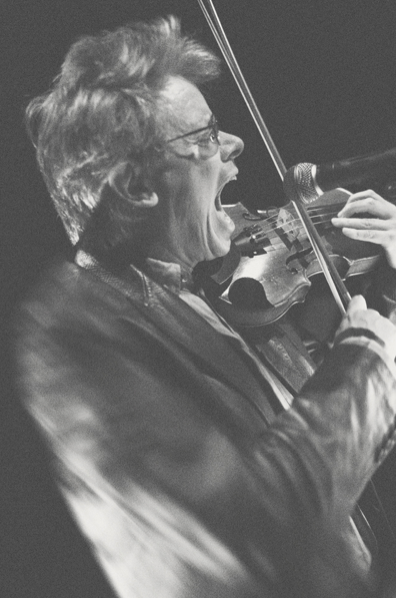


Tod Machover
Backing Track
This pieces includes a five-part backing track.
Learn more about the electronics and download the files here:
Gammified includes stereo electronics that play continuously throughout the piece, with the start of each of the five tracks marked in the score. (Each of the tracks should ideally be routed through different stereo channels on a mixer so that each new track overlaps with the last, with the previous track faded out at the discretion of the sound engineer/quartet.)
The electronic layer of the piece is based on spectra constructed over a 40 Hz. drone. This drone is mixed with other sonorities – studio-produced as well as sampled/processed from Kronos - to keep the ear interested while the mind is meditating. The string quartet part is meant to blend with the electronics, neither dominating nor disappearing, and creates a musical journey from pedal to pulsation to spectral shimmering to melody to harmonic resolution. The quartet is asked to listen carefully to the electronics while performing, interacting, imitating and occasionally improvising.
Download Backing Track
Program Notes
Gammified
(2019)
Tod Machover
(b. 1953)
Composed for
50 For The Future:
The Kronos Learning
Repertoire
Artist Statement
“I composed Gammified for Kronos Quartet – as part of the Fifty for the Future series – in spring 2019, and made some small revisions in January 2021. The work is scored for amplified quartet plus stereo electronics, with the quartet being amplified just enough to blend in volume and timbre with the electronics. The electronics play continuously during the ca. 9-minute composition, with the start of each of the five tracks marked in the score. (Each of the tracks should ideally be routed through different stereo channels on a mixer so that each new track overlaps with the last, with the previous track faded out at the discretion of the sound engineer/quartet.)
“Gammified is based on current research at the MIT Media Lab where I work, as well as in the MIT labs of Prof. Li-Huei Tsai and Prof. Ed Boyden. Over the past five years, this research has shown that frequencies of ca. 40 Hz. (approximately the low-E on the piano) play fundamental roles in our brains. Specifically, healthy brains hum with this frequency, which in turn activates many functions central to mental sharpness. One important function of Gamma frequencies is to stimulate activity in microglial cells, which are the primary immune cells in the brain and also destroy pathogens and remove damaged cells. The Tsai/Boyden teams made the important discovery that mice bred with Alzheimer’s disease actually had missing or intermittent Gamma frequencies in their brains, and the effect was that microglial cells were unable to clean up the plaque debris that causes the disease. By exposing the mice to Gamma frequencies (first with flashing light, then with audio drones), microglial cells became active again, plaque was removed, and Alzheimer’s symptoms were reversed. This discovery was huge, since no medicine or surgery can reverse Alzheimer’s – but apparently sound and/or light can do it!
“For the past several years, my Opera of the Future team at the MIT Media Lab has been working with the Tsai/Boyden teams to see if Gamma frequencies can affect people as – or even more – effectively than they affect mice. And the news is good. Our work shows that humans can be successfully exposed to sound or light at 40 Hz. – with especially surprising results when both are combined – in a way that kickstarts the brain into producing Gamma frequencies again. We have been working to find out exactly which combinations of frequencies, overtones and spectral envelopes, with a 40 Hz. fundamental, are most effective for producing this “entrainment,” and how these spectra can be best combined with music, to make this Gamma therapy beautiful and compelling as well as useful in helping to ameliorate a number of mental problems (from Alzheimer’s to Parkinson’s disease, depression and distraction).
“Gammified is my first attempt to create a musical work based around therapeutic Gamma frequencies. The electronic layer of the piece is based on spectra constructed over a 40 Hz. drone. This drone is mixed with other sonorities – studio-produced as well as sampled/processed from Kronos - to keep the ear interested while the mind is meditating. The string quartet part is meant to blend with the electronics, neither dominating nor disappearing, and creates a musical journey from pedal to pulsation to spectral shimmering to melody to harmonic resolution. The quartet is asked to listen carefully to the electronics while performing, interacting, imitating and occasionally improvising. The duration of Gammified is probably not long enough to produce complete mental entrainment (although we are studying that effect now), but my hope is that the piece will promote careful listening, mental focus and emotional satisfaction, as well as invite curiosity about this exciting new world where sensory experiences – simple sounds and sights, without medicine or surgery – can target specific brain processes to cure mental diseases and to keep our minds as healthy as possible.”
Special thanks to M.I.T.’s Center for Art, Science and Technology (CAST), which provided additional funding and support for the creation and development of Gammified.
Composer Interview
Tod Machover discusses his musical background, his relationship with Kronos, the piece he wrote for Fifty for the Future, and more.
Support Kronos’ 50 for the Future
Help support Kronos’ 50 for the Future as we develop this new learning library.Artist’s Bio
Tod Machover
USA
Tod Machover is Muriel R. Cooper Professor of Music and Media at the MIT Media Lab, where he is also director of the Lab's Opera of the Future group. Called a “musical visionary” by The New York Times and “America’s most wired composer” by The Los Angeles Times, Machover is an influential composer and inventor, praised for creating music that breaks traditional artistic and cultural boundaries and for developing technologies that expand music’s potential for everyone, from celebrated virtuosi to musicians of all abilities. Machover studied with Elliott Carter and Roger Sessions at The Juilliard School and was the first Director of Musical Research at Pierre Boulez's IRCAM in Paris. He is also Visiting Professor of Composition at the Royal Academy of Music (London) and at the Curtis Institute of Music (Philadelphia).
Machover’s music has been performed and commissioned by many of the world's most important performers and ensembles, including Lincoln Center for the Performing Arts, the Los Angeles Philharmonic, the Lucerne Festival, the Tokyo String Quartet, Kronos Quartet, and the Philadelphia Orchestra. He has received numerous prizes and honors, including from the American Academy of Arts and Letters, the Fromm and Koussevitzky Foundations, the National Endowment for the Arts, and the French Culture Ministry, which named him a Chevalier de l'Ordre des Arts et des Lettres. He was finalist for the 2012 Pulitzer Prize in Music and was the inaugural recipient of the Arts Advocacy Award from the Kennedy Center for the Performing Arts in 2013. In 2016, he was named Composer of the Year by Musical America.
Machover is widely recognized for designing new technologies for music performance and creation, such as Hyperinstruments, “smart” performance systems that extend expression for virtuosi, from Yo-Yo Ma to Prince, as well as for the general public. The popular videogames Guitar Hero and Rock Band grew out of Machover’s group at the Media Lab. His Hyperscore software—which allows anyone to compose original music using lines and colors—has enabled children around the world to have their music performed by major orchestras, chamber music ensembles, and rock bands. Machover is also deeply involved in developing musical technologies and concepts for medical and wellbeing contexts, helping to diagnose and reverse conditions such as Alzheimer’s disease, or allowing people with cerebral palsy to communicate through music.
Machover is especially known for his visionary operas, including VALIS (based on Philip K. Dick’s sci-fi classic and commissioned by the Centre Georges Pompidou in Paris); Brain Opera (which invites the audience to collaborate live and online); Skellig (based on David Almond’s award-winning novel and premiered in the UK at the Sage Gateshead); the “robotic” Death and the Powers (of which an audiophile CD will be released in spring 2021); and Schoenberg in Hollywood (commissioned/premiered by Boston Lyric Opera and touring Europe starting in the 2021/2022 season).
Machover has recently worked on a series of “collaborative city symphonies” to create sonic portraits of cities for, and with, the people who live there. So far, City Symphonies have been produced for Toronto, Edinburgh, Perth, Lucerne, Detroit, Miami and Philadelphia, and a new series of projects for cities around the world is in process. Other recent and upcoming works include Sorta Voce for cellist Matt Haimovitz, a new work for soprano Renée Fleming with string quartet and electronics, a work for solo violin and electronics for the 200th anniversary of the Royal Academy of Music, a composition for chamber orchestra and electronics for the Bath (UK) Festival Orchestra, and a new opera whose main characters are trees. In addition, Machover is working on a series of installations and technologies that continue to expand individual creativity, while establishing multisensory collaboration and empathy within communities and across the globe.

Tod's vision of sonic possibilities and his work within the science of sound and acoustics seemed like a natural fit in Fifty for the Future. Not only do I love the piece he's made for us, but he's also just a wonderful person to talk to and trade ideas with. I want people who are embracing as much as they can of humanity, and for me, Tod is one of those really encouraging forces in life.


World Premiere


